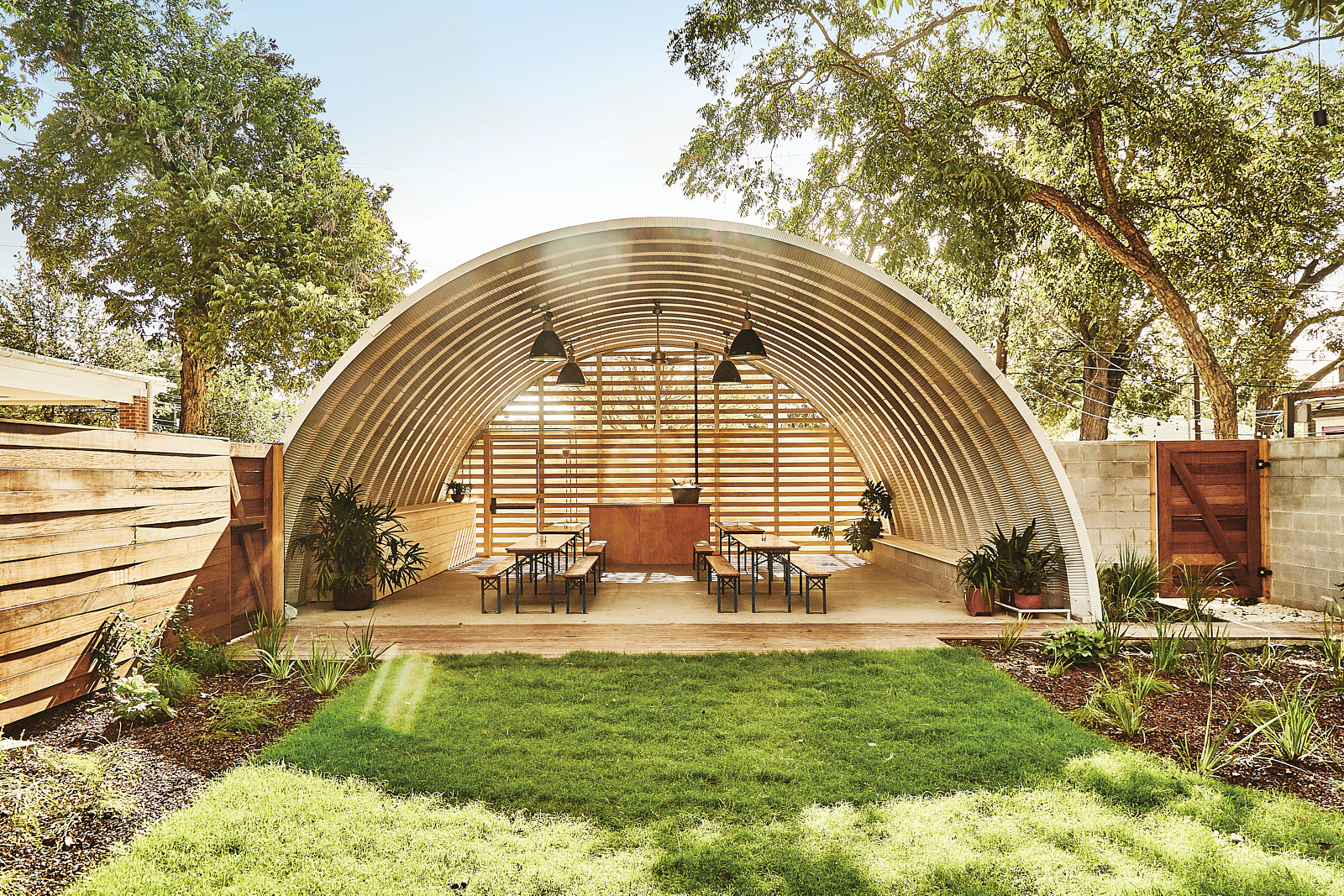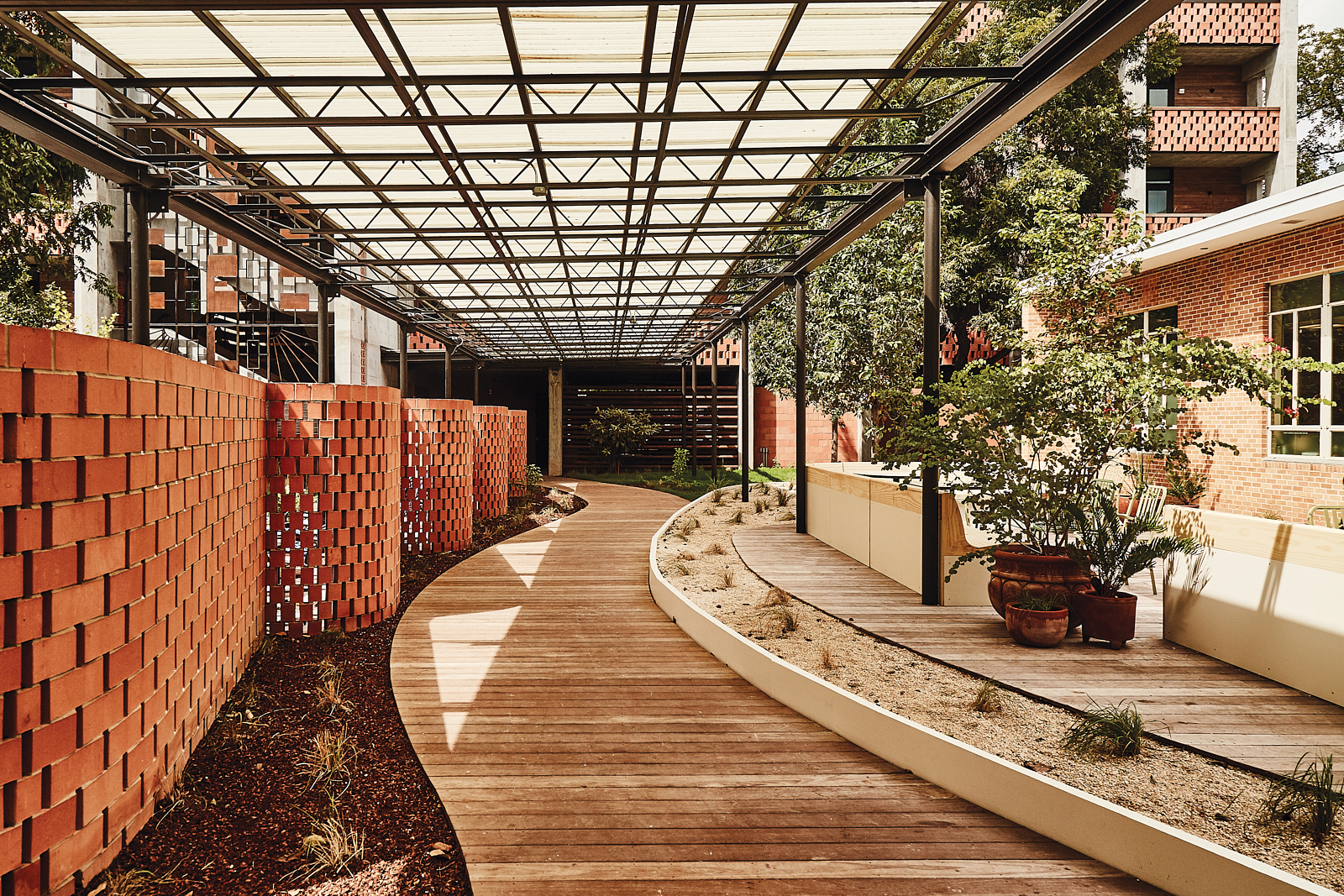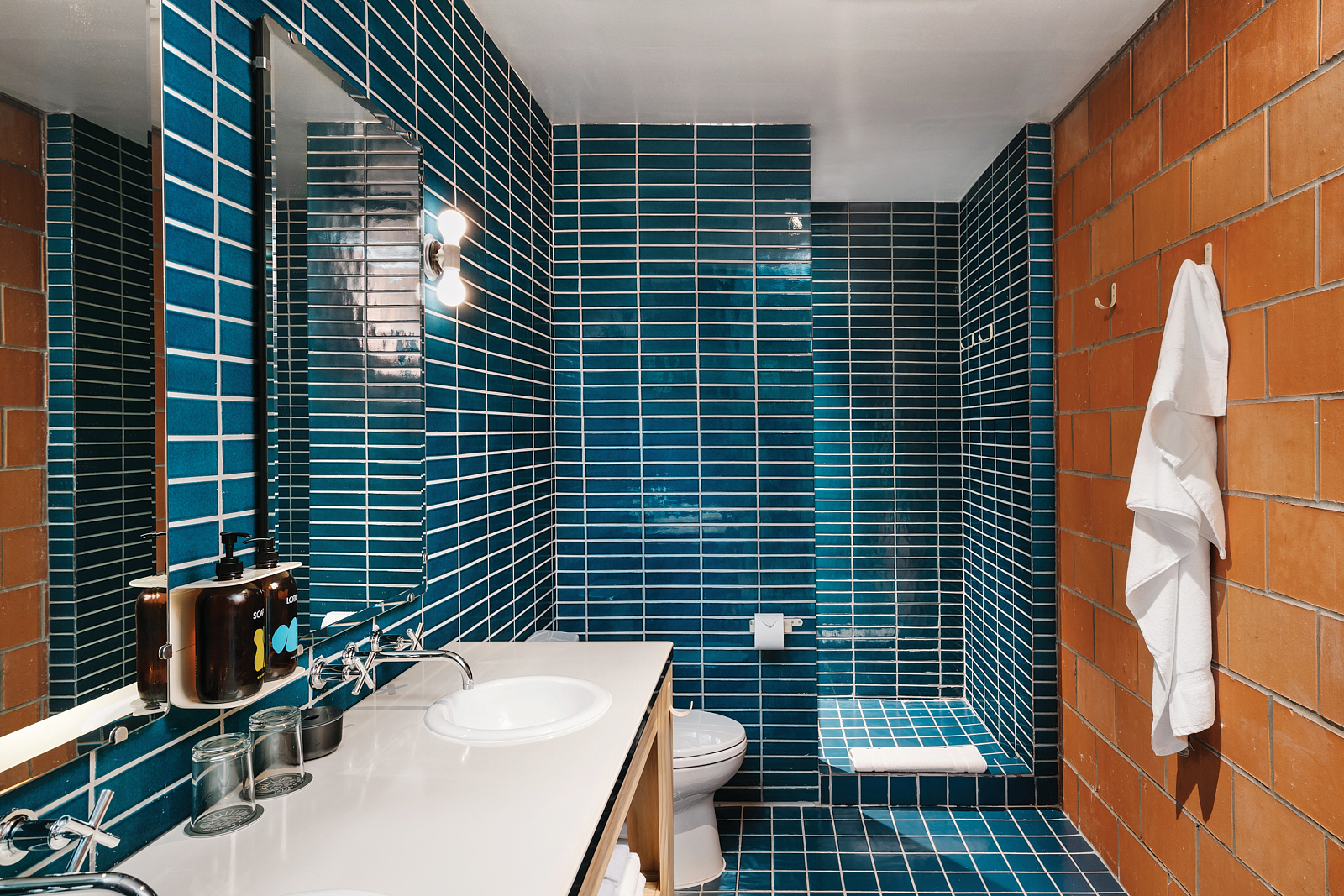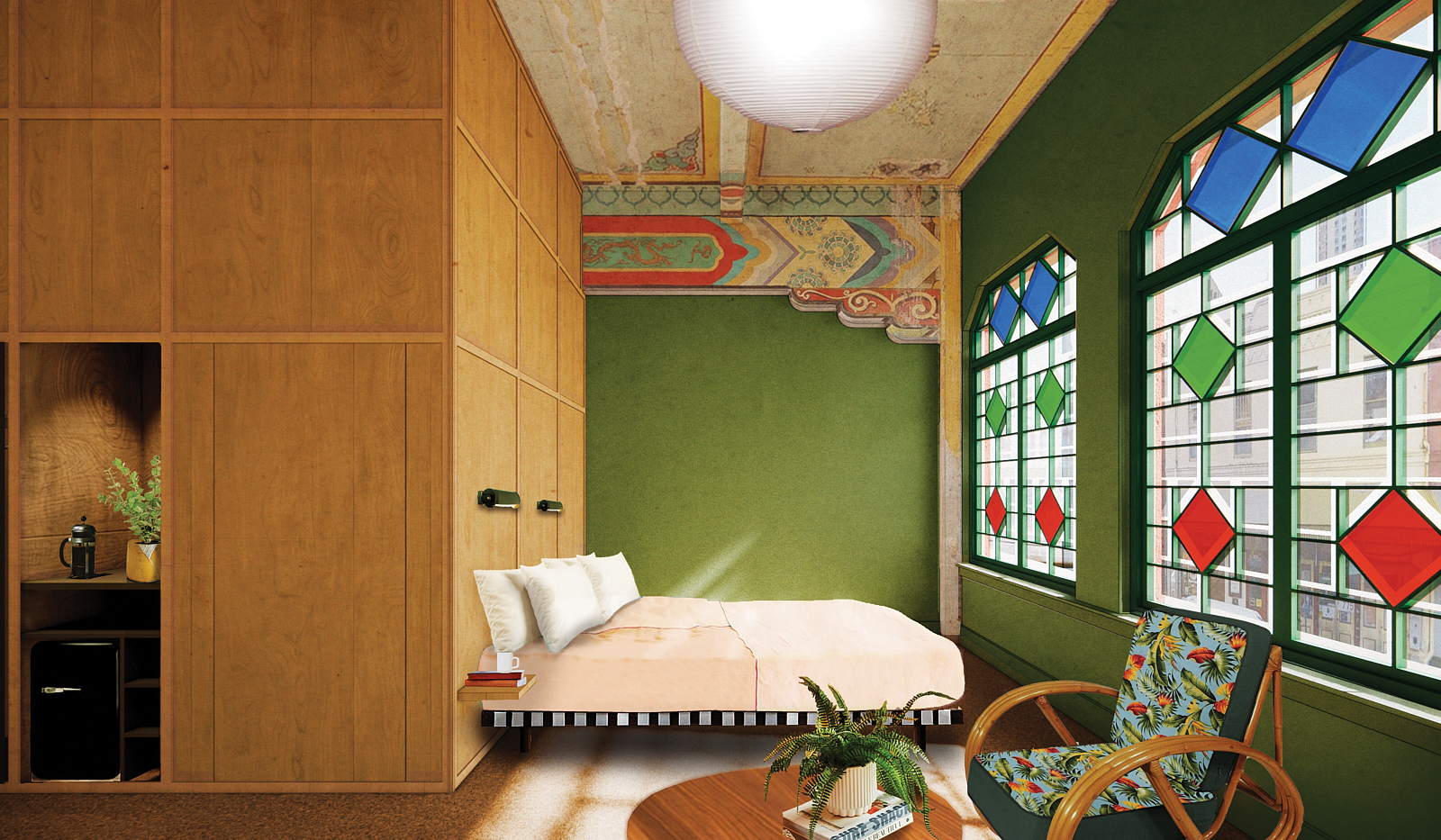This Visionary Architect is Turning Unexpected Places Into Destination Hotels

Before it was transformed into a hip boutique hotel in Austin, the Carpenter Hotel was a nondescript meeting hall for a carpenters union. Unless you were a carpenter, you probably never noticed the one-story brick building surrounded by a pecan grove, even though it’s mere blocks away from Barton Springs. But architect Jen Turner saw potential in the structure and its surroundings, especially the trees. “You can’t even begin to put this kind of charm into a site,” she says. And so, she took on her first hotel project.
“To be honest, I never thought I’d be doing hotels, but here I am,” says Turner, who co-founded the hospitality group The Mighty Union with her husband, Jack Barron. Their mission is simple: inject new life into older, disused buildings.
Since 2014, their projects have included revamping Suttle Lodge in Deschutes National Forest near Bend, Oregon, and reimagining that 1948 carpenters union building as the Carpenter Hotel. Turner, BArch ’98, leads on construction and project management, and shares designing and creative directing with Barron, who also handles business development. Partner Donald Kenney completes the triangle by overseeing operations. Their next project is transforming the oldest chop suey restaurant in Honolulu’s Chinatown district into a 23-room boutique hotel. It’s on track to open next summer.

From an early age, Turner’s mother nudged her toward historic preservation. Real estate development was also in her blood. Born in Houston, she grew up moving around—first Conroe, then Katy, and then Sugar Land (“every little town that became subsumed by Houston,” she says)—due to her father’s work. He was a vice president with Gerald Hines, the master planner who transformed Houston’s skyline and developed the factory town of Sugar Land.
The oldest of seven siblings, Turner enjoyed art and took classes at the Glassell School of Art in downtown Houston while in high school. She started contemplating a career in architecture with a focus on historic preservation. “I thought of architecture as more akin to art, and just one of those art sciences,” she says. “And I knew enough that historic preservationists were usually architects as well.”
Graduating near the top of her class, she considered other colleges (Texas Christian University offered her a scholarship) before making a last-minute decision to apply to The University of Texas at Austin. She planned to major in business and get a master’s in architecture, but after finding business classes a tad boring, she applied to the School of Architecture and got in. As soon as she began taking design courses, she dropped historic preservation to focus on design and ideation. It would be years later when her interest in historic buildings would return.
To complete her degree, Turner interned at the husband-and-wife architecture firm of Tod Williams Billie Tsien in New York City. A small firm at the time, Turner was able to easily integrate herself into its community, according to Williams. “During her internship, we began to realize that she was just a great spirit—upbeat, curious, willing to put her shoulder to any task we put in front of her,” he says. “She was exceptional.”

After graduation, she returned to the city and job offers started coming in. She sought the advice of her former bosses, who offered her a job on the spot, and she impressed them with her ambition, open-mindedness, and easy rapport with clients.
“She’s a strong woman. She’ll always say what’s on her mind. She’s just very, very open,” Tsien says. “She also has an offbeat, wacky side, which I think expresses itself in very interesting ways.”
During her 11 years with the firm, Turner worked on the Natatorium in Cranbrook, the Johns Hopkins University Creative Arts Center, and the Museum of American Folk Art. But by 2009, she was ready to branch out on her own, focusing on exhibit design for the Museum of the City of New York and furniture design, which she continues to do for The Mighty Union.
By 2013, Turner had met Barron. Also an architect, he was a partner with the Ace Hotel group and worked on their boutique hotels in Portland, Palm Springs, and New York (he’s still co-owner of the Portland hotel). Both Texas natives, the couple decided to relocate to Austin.
“We both wanted to be warm again,” Turner says, “and to be somewhere where we could live inside and outside all the time.”
A year later, an investment group bought the carpenters union building. “We loved the building from first sight,” Turner says. “It just felt so familiar.” The investors were considering turning it into offices or making some other use of it until The Mighty Union pitched the idea of transforming it into a hotel and restaurant.

While Turner says she leans modern in her designs, she takes inspiration from the surroundings of a building. So, she made sure to keep the pecan trees around the property and added Texan elements, including walls made with terra cotta bricks by the D’Hanis Brick and Tile Company of San Antonio.
Echoing Tsien’s description of Turner, Barron describes his wife and partner as the only true professional of the Mighty Union bunch.
“She brings a level of rigor and insight that we desperately needed,” he says.
As a couple who works together, he adds that the biggest joy has been bringing along their 7-year-old son, Dash. Barron describes him as a “bohemian Eloise at the Plaza.”
“We used to joke that he had toured more derelict buildings before he was 5 years old than most people do in a lifetime,” he says. “It took us a while to make him understand that he wasn’t allowed in every restaurant kitchen, only ours.”
In the almost 25 years that Turner has been an architect, she has accepted that projects come and go, but the pandemic has made her line of work particularly difficult. The hospitality industry has been hit hard, and in The Mighty Union’s case, they saw $1 million on the Carpenter Hotel books get canceled when SXSW announced it wasn’t happening in 2020. That July, to pay off debt, Turner says, the Carpenter acquired a new ownership entity. In spring 2021, The Mighty Union’s management contract was bought out.
“It was bittersweet,” Turner says, “but like many things in life, things always change. It also helps in hindsight to crystallize things, like how we want to structure things. In a way, it’s a gift to learn those things before the next project.”

The pandemic also resulted in a halt to The Mighty Union’s San Antonio project (it still may happen, Turner says). But there has been a positive for the group: They experienced their best year at Suttle Lodge in 2020, which Turner attributes to its location outside of an urban center, as people felt safer taking road trips and staying in cabins as opposed to crowding into downtown hotels.
Claiming not to be an expert, Turner believes it’s still too early to see how much the hospitality industry will change or how long COVID’s impact will last. What she does know is the industry is having a hard time adapting to its new reality. “People are really struggling to come up with the service that may have taken place before and at the same prices,” she says.
This year, Turner and Barron moved the family to Santa Fe, New Mexico, where they spent much of 2020. They hope to purchase a 12-acre property with five buildings from the Archdiocese of Santa Fe. But even that project has its hurdles, including major renovation work and the sale being tied up in bankruptcy court.
“We really hope that it can move forward, because we love the project,” she says. “If not, there’ll be something else. That’s how it always is, right?”
CREDITS: Clair Cottrell, Alex Lau (2), The Mighty Union, Chase Daniel





